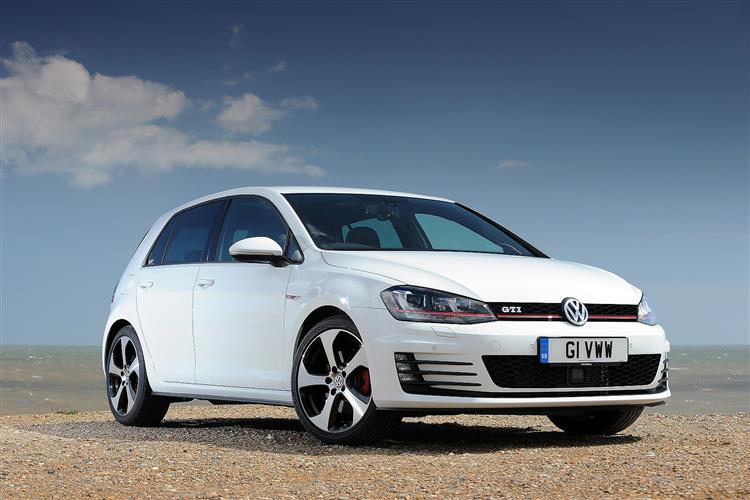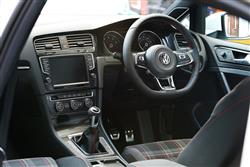This is a sample, showing 30 seconds of each section.
THE ORIGINAL & THE BEST? (some text hidden) SECTIONED_new_volkswagengolfgti_2014
By Jonathan Crouch
Introductionword count: 80
The Volkswagen Golf GTI wears one of the most iconic badges around and this post-2012 Mk7 model proved to be a class act. It was bigger, quicker, better built and more efficient than its predecessor, offering a choice of three doors or five, standard or 'Performance Pack' models and manual gearbox or DSG semi-auto transmission. This car proved to be the best all-rounder from its era in the hot hatch division. But does it make sense on the used market?
Modelsword count: 9
3dr/5dr Hatch (GTI, GTI Performance Pack, GTI Clubsport S)
Historyword count: 397
Before Volkswagen dreamed up the Golf GTI, there was no such thing as a 'hot hatchback'. Today of course, the phrase has entered everyday parlance and virtually any manufacturer that has a hatchback also has a hot one - or a warm one at the very least. It was 1976 when the original version of this car was born and since then, through continual generations and with the help of countless imitators, it has brought performance, handling and fun to the masses on an unprecedented scale. The Golf GTI we look at here was the mark seven version and claimed to be the best yet at its original launch in 2012. But did that mean 'best of breed' or 'best in class'? This car, after all, may define the hot hatch genre but prior to 2012, it had rarely been recognised as the most accomplished car in its sector. In fact, to be brutally honest, there have been some distinctly average Golf GTI models over the years, the low point reached in the Nineties with unremarkable third and fourth generation models. All that changed though, in 2005 with a completely re-developed fifth generation version that also lent its platform and most of its 2.0-litre turbo mechanicals to the slicker MK6 design that followed in 2009. For the first time since the Seventies and early Eighties, a hot Golf was a credible driver's choice once again. By 2012 though, Volkswagen's iconic shopping rocket was beginning to be overtaken by a whole host of rivals, all of whom offered more firepower and greater technical superiority. Another big step forward was called for - and this seventh generation Golf GTI claimed to represent exactly that. Wolfsburg's hi-tech MQB platform made it lighter and more efficient, there was hi-tech suspension and steering, plus extra power up-front (220PS) along with the option of a pokier Performance Pack (boosting output to 230PS) if that wasn't enough. A rorty three-door GTI Clubsport S version with 310PS was launched in 2016. And the standard GTI was facelifted, along with the rest of the Golf range, for the 2017 model year, an update that boosted power of the standard model to 230PS and that of the 'Performance Pack' variant to 245PS. In 2018, the standard 230PS model was phased out and only the 'Performance Pack' variant remained until the end of the production cycle in 2019.
What You Getword count: 1294
What do you think of in terms of the small but significant distinguishing features that have always marked out a Golf GTI from its ordinary stablemates? The red stripe around the radiator grille? The black border around the rear screen? The smaller sports steering wheel, golf ball-shaped gear knob or tartan-trimmed seats? All of these things have characterised this model line for nearly forty years and back in 2012 when this MK7 Golf GTI was first launched, Volkswagen wasn't about change them. But subtle evolution was required for this seventh generation version - and that's exactly what we got. One glance might suggest that this car isn't much different from what went before. Take another. A new MQB platform gave this model a sportier, more dynamic stance. That's down to the way that the front wheels were moved further forward, reducing the front overhang, visually lengthening the V-shaped bonnet and moving the passenger compartment a little towards the rear. The result is a gym-toned look that's particularly nice at the side, with the C-pillar design supposed to resemble the drawn string of a bow, giving the Golf a look of acceleration even when it's standing still. Confident and assertive then, without being overly showy - but then this has never been a model to champion lairy spoilers and drainpipe exhausts. Instead, you get a car that sits 15mm lower to the road than its humbler siblings, the lovely 18-inch alloy wheels with their red callipers filling the arches purposefully. As is usually the case, the three-door version looks a bit better than its five-door counterpart, the longer doors having the visual effect of lengthening and lowering the profile. On to the detail visual changes made to the MK7 Golf GTI. At the front end, you get a red styling line that extends not only across the grille but also clean through bi-xenon light clusters that sit above three lateral high gloss black aerodynamic fins sitting either side of the honeycomb-trimmed screen that covers the lower air intake. At the side, there are red-on-chrome 'GTI' wing vents that begin the stronger of the two character profile lines, a crease that flows down the flanks into a silver centre section of smoked LED tail lights marking out a rear hatch styled to continue the understatedly purposeful theme. The roof spoiler is supposed to be larger than that found on any ordinary Golf but you wouldn't know it. More obvious are the twin chromed tailpipes that sit either side of a black diffuser. Take a seat inside and there's just enough differentiation to justify this car's heritage and substantial asking price. We've already mentioned the three features that brand aficionados will expect - the chunky three-spoke sports wheel, the tartan seat coverings and the golf ball-shaped gear knob. But this cabin is anything but a throwback, with buttons and switches precisely where you'd want to find them and everything just as it should be. The carpet that lines the storage boxes so that your keys don't scrape around on the move. The upholstered material used for the upper section of the dashboard that's lovely to the touch. The central armrest that adjusts for length and five stages of height. And a 2Zone climate control system that can even adjust itself according to the direction of the sun. It's better than a BMW from this era, every bit as good as an Audi from this period and it all means that if you were to sit in a Ford Focus ST or a Renaultsport Megane from this time after driving one of these, it'd be a bit like stepping from Harvey Nichols into Primark. Could it be a little more showy? Perhaps, but the red stitching, the dark roof fabric, the GTI trim strips and the stainless steel pedal caps do just enough to set the performance theme. Can the same be said of the red ambience lighting? We think it a little 'Hamburg night club': you may disagree. At least Volkswagen resisted the urge to slather this cabin with carbon fibre, material that at one point was going to be used for the entire roof section - until the idea was abandoned due to the production complications it would have created at the Wolfsburg and Zwickau factories. If you come to this seventh generation model fresh from its direct MK6 predecessor, you'll find yourself feeling slightly more comfortable at the wheel but perhaps unable to precisely reason why. Let us tell you. The brilliantly comfortable seat was shifted back for the seventh generation model, at the same time as the pedals were made a little more widely spaced and there was more adjustment possible from the leather-trimmed, flat-bottomed multi-function steering wheel, through which you view lovely instrument dials reminiscent of high-end chronometers. Start the engine and the needles swing once to the end scale position and then back. Lovely. In between the gauges is a centre display with carousel-style graphics that deliver everything from sat nav information to a lap timer. Some of this information is also replicated on the colour infotainment touch screen that dominates the centre of the dash and will be the biggest cabin change for buyers of previous GTI models, a feature you can control merely by swiping your finger across its surface as you do on a smart 'phone. In early MK7 Golf GTI models, it was 5.8-inches in size as standard but could be upgraded to an 8-inch item if, as was mostly the case, the original buyer opted for the more sophisticated sat nav option. The 8-inch screen was standardised after the 2017 model year facelift. This display is the starting point for operation of the Driver Profile selection system that can alter the throttle mapping and engine management set-up to suit your chosen driving style. More conventionally, there's access the stereo with its DAB digital radio, the trip computer and all manner of Bluetooth telephony - enough to make your mobile device feel right at home. Especially if your car has been fitted with the 'Advanced telephone connection' option that'll enable you to link it in to the car's external aerial for improved reception. Thankfully, ventilation controls were left off the menu of screen functions, operable instead by three chunky dials below. Stabbing away at a touchscreen every time you want to change the fan speed or cabin temperature is a modern innovation most owners, we think, could do without. A bit like the electronic handbrake in fact, something you have to have here. In the back seat, you'll most notice the improvements wrought through the introduction of the hi-tech MQB platform - and the 53mm wheelbase increase it allows. Rear legroom rose with this MK7 model by 15mm, despite the change we mentioned earlier, that of the front seats being moved further back to better suit taller drivers. Shoulder and elbow-room were both improved too and headroom's also quite adequate, despite this generation model's small reduction in exterior roof height. As usual in this class, three adults would be a little squashed here but a trio of kids will be quite happy. Out back, there's more space for luggage than there was in the MK6 Golf GTI, the cargo bay 30-litres larger than before at 380-litres - that's 10% bigger than a Megane Renaultsport from this time and 20% bigger than a Focus ST from this period. It's easier to use too, with probably the lowest loading sill height in the class, a wide hatch aperture and a wide base on the dual-height luggage floor. There's a ski hatch too for longer items. Fold the 60/40 split rear seats down and you get useful 1270-litres - again one of the biggest spaces in the class from this era.
To see the full road test text contact us on 0330 0020 227
Pictures (high res disabled)

.jpg)
|
.jpg)
|
.jpg)
| |||
.jpg)
|
.jpg)
|
.jpg)
| |||
.jpg)
|
.jpg)
|
.jpg)
| |||
.jpg)
|

|
Scoring (subset of scores)
Category:
| Performance | |
| Handling | |
| Comfort | |
| Space | |
| Styling, Build, Value, Equipment, Depreciation, Handling, Insurance and Total scores are available with our full data feed. | |



